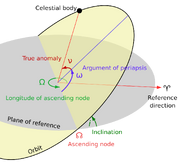Universesandbox erika (talk | contribs) (Added page for Orbital Elements) |
Universesandbox erika (talk | contribs) mNo edit summary |
||
| (3 intermediate revisions by the same user not shown) | |||
| Line 1: | Line 1: | ||
| − | [[File:Orbital Elements Diagram.png|thumb|Diagram showing the four of the six orbital elements used to describe an object's orbit. Source: [[commons:File:Orbit1.svg|Wikimedia Commons]]]]An object's orbit can be described with six properties, known as its [https://en.wikipedia.org/wiki/Orbital_elements orbital elements]. These six properties include: |
+ | [[File:Orbital Elements Diagram.png|thumb|Diagram showing the four of the six orbital elements used to describe an object's orbit. Source: [[commons:File:Orbit1.svg|Wikimedia Commons]]]]An object's [[orbit]] can be described with six properties, known as its [https://en.wikipedia.org/wiki/Orbital_elements orbital elements]. These six properties include: |
* the [[Semi-Major Axis]], described the size of the orbit, |
* the [[Semi-Major Axis]], described the size of the orbit, |
||
* the [[Eccentricity]], describing the shape of the orbit, |
* the [[Eccentricity]], describing the shape of the orbit, |
||
| Line 6: | Line 6: | ||
* the [[Longitude of the Ascending Node]], two angles describing the orientation of the orbit in space, and |
* the [[Longitude of the Ascending Node]], two angles describing the orientation of the orbit in space, and |
||
* either the [[True Anomaly]] or the [[Mean Anomaly]], both of which describe the object's position along its orbit. |
* either the [[True Anomaly]] or the [[Mean Anomaly]], both of which describe the object's position along its orbit. |
||
| + | |||
| − | The orbital elements are calculated relative to the |
+ | The orbital elements are calculated relative to the object's [[Orbital Parent]]. |
As an alternative to the orbital elements, an object's location and motion in 3D space can also be described with six other properties: the x, y, z components of its [[Position Vector]] and the x, y, z components of its [[Velocity Vector]]. |
As an alternative to the orbital elements, an object's location and motion in 3D space can also be described with six other properties: the x, y, z components of its [[Position Vector]] and the x, y, z components of its [[Velocity Vector]]. |
||
| + | |||
| + | |||
| + | [[Category:Orbital Mechanics]] |
||
| + | [[Category:Physics]] |
||
Latest revision as of 08:08, 5 September 2019

Diagram showing the four of the six orbital elements used to describe an object's orbit. Source: Wikimedia Commons
An object's orbit can be described with six properties, known as its orbital elements. These six properties include:
- the Semi-Major Axis, described the size of the orbit,
- the Eccentricity, describing the shape of the orbit,
- the Inclination, describing the the tilt of the orbit,
- the Argument of Pericenter and
- the Longitude of the Ascending Node, two angles describing the orientation of the orbit in space, and
- either the True Anomaly or the Mean Anomaly, both of which describe the object's position along its orbit.
The orbital elements are calculated relative to the object's Orbital Parent.
As an alternative to the orbital elements, an object's location and motion in 3D space can also be described with six other properties: the x, y, z components of its Position Vector and the x, y, z components of its Velocity Vector.
